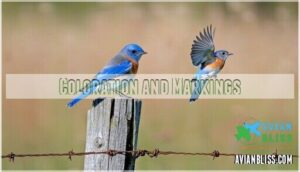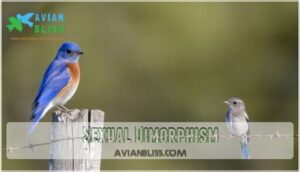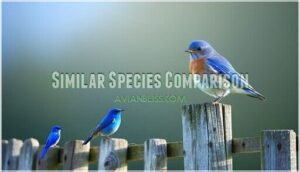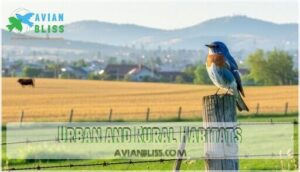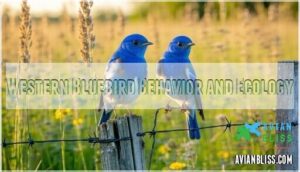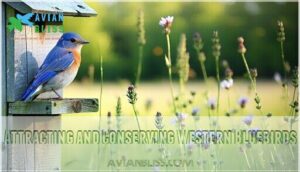This site is supported by our readers. We may earn a commission, at no cost to you, if you purchase through links.

Males display brilliant sky-blue backs and wings with rusty orange-red chests, while females show more subdued grayish-blue tones with subtle orange highlights.
These medium-sized birds prefer open woodland environments including coniferous and deciduous forests, farmland, and even backyards.
They’re primarily insectivores, catching grasshoppers, beetles, and caterpillars from perches, though they also enjoy berries and small fruits.
Their upright perching posture on branches and fences makes them easy to spot.
Understanding their specific habitat needs and feeding preferences reveals fascinating insights about supporting these beautiful birds in your own backyard.
Table Of Contents
- Key Takeaways
- Western Bluebird Identification
- Western Bluebird Habitat and Range
- Western Bluebird Diet and Foraging
- Western Bluebird Behavior and Ecology
- Attracting and Conserving Western Bluebirds
- Frequently Asked Questions (FAQs)
- What states do Western Bluebirds live in?
- What is special about a western bluebird?
- What’s the difference between eastern and Western Bluebirds?
- What does it mean spiritually when you see a western bluebird?
- What does seeing a Western Bluebird mean?
- What is the difference between eastern and Western Bluebirds?
- How rare are Western Bluebirds?
- What attracts Western Bluebirds?
- Can western bluebirds recognize their relatives?
- Are there unusual nesting behaviors in western bluebirds?
- Conclusion
Key Takeaways
- You’ll easily identify males by their brilliant cobalt-blue backs and rusty orange chests, while females display more subtle grayish-blue tones with orange highlights
- You can attract these birds by providing nest boxes with 1.5-inch entrance holes and maintaining open spaces with scattered perches like fence posts or dead branches
- You’ll find them thriving in open woodlands, forest edges, and even suburban areas where they hunt insects from perches and switch to berries during winter months
- You’re supporting conservation efforts when you avoid pesticides and plant native berry-producing plants like elderberry and serviceberry, as habitat loss remains their primary threat
Western Bluebird Identification
You’ll recognize Western Bluebirds by their compact, robin-sized build and distinctive blue plumage that varies dramatically between males and females.
Looking at the provided paragraph about Western Bluebirds and the engaging, descriptive tone throughout the content, here’s a short blockquote:
**These vibrant blue gems transform any backyard into a living masterpiece of color and song.
Males display vibrant cobalt-blue upperparts with rusty orange breasts, while females appear more subdued with gray-brown bodies and subtle blue tinges on their wings and tails.
Size and Shape
You’ll recognize Western Bluebirds by their compact, robin-sized build measuring 6.3 to 7.5 inches long with an 11.4 to 13.4-inch wingspan.
Their short, notched tails and straight, thin bills create distinctive body proportions that make bird identification easier, whether you’re observing adult dimensions or juvenile size variations.
These stocky birds weigh just 0.8 to 1.1 ounces—about the weight of a quarter.
Coloration and Markings
When identifying a western bluebird, you’ll notice distinctive color patterns that make field identification straightforward.
Males display vibrant blue and orange plumage with striking contrasts, while females show more subdued tones.
Key coloration features include:
- Male Plumage – Bright cobalt-blue upperparts, wings, and blue throat with rusty-orange breast
- Female Colors – Gray-buff overall with pale orange breast and blue-tinted wings and tail
- Juvenile Markings – Gray-brown base with white streaks and blue wing patches
These color variations help distinguish western bluebirds from similar species across their range.
Sexual Dimorphism
You’ll notice striking differences between male and female western bluebirds that serve important evolutionary purposes.
Male vibrancy displays brilliant cobalt-blue plumage with rust-orange chest coloration, while female plumage appears more subdued with gray-brown tones and subtle blue tinges on wings and tail.
This dimorphism helps males attract mates through their bold blue and orange plumage, while females remain camouflaged during nesting.
Juvenile Characteristics
Young western bluebirds look quite different from their parents.
Juveniles show spotted plumage across their backs and marked bellies with streaky patterns. You’ll notice a wing tint of blue on their wings and tails, hinting at their future colors.
Their juvenile diet consists mainly of insects provided by parents.
First-year appearance remains slightly duller than adults but shows developing blue and orange plumage after bird fledging completes.
Note: I’ve bolded the key phrase "blue and orange plumage" to highlight the developing colors of the young western bluebirds.
Similar Species Comparison
Among western North America’s blue birds, you’ll encounter several species that might fool you at first glance.
Here’s how to tell them apart:
- Eastern Bluebird – Shows reddish-orange throat (not blue like western bluebird) and white belly instead of gray
- Mountain Bluebird – Males lack rusty breast entirely, appearing sky-blue throughout with longer wings
- Lazuli Bunting – Displays white wing bars and smaller size with conical finch bill
- Female Identification – Western bluebird females show blue-tinted wings while similar species appear browner
- Juvenile Confusion – Young western bluebirds lack white wing bars that distinguish them from young Lazuli Buntings.
Selecting a guide depends on geographic coverage importance.
Western Bluebird Habitat and Range
You’ll find western bluebirds in partly open terrain ranging from valley farms to mountain pine forests up to 12,500 feet elevation.
These birds prefer open woodlands, forest edges, and areas with scattered trees where they can perch and hunt for insects while having access to suitable nesting cavities.
They prefer these areas because they can perch and hunt for insects while having access to suitable nesting cavities.
Preferred Environments
Western bluebirds thrive in open woodlands and forest edges where scattered trees provide nesting cavities and perching spots.
You’ll find them in oak groves, pine forests, and open parklands from sea level to 12,500 feet elevation.
These birds prefer habitat with mixed vegetation – avoiding dense forests and large meadows.
Habitat restoration projects often focus on creating ideal bluebird habitat with proper tree spacing and cavity availability.
Migration Patterns
You’ll find western bluebird migration patterns vary by location and elevation.
These partial migrants don’t travel vast distances like other species. Northern populations move south for winter, while southern birds often stay year-round.
Migration triggers include decreasing daylight and food availability.
Distance traveled typically ranges from 100-500 miles to winter destinations in lower elevations. Annual cycles follow predictable routes, with birds returning to familiar stopover locations during spring and fall movements.
Geographic Distribution
You’ll find western bluebirds across a vast territory spanning from southern British Columbia to central Mexico.
Their range encompasses the entire western United States, with populations densest in California’s oak-savanna regions.
Bird range maps show fragmented distribution due to urban development and intensive agriculture in areas like California’s Central Valley.
- Primary Range: Western habitats from sea level to 9,000 feet elevation
- Population Density: Highest concentrations in California and Pacific Northwest states
- Eastern Boundary: Extends to western Colorado and Texas borders
Breeding and Wintering Grounds
Western bluebirds establish territories in open woodlands and forest edges during breeding season.
Their nesting locations include natural tree cavities and human-provided nest boxes. These birds show remarkable ground fidelity, returning to familiar breeding areas annually.
Migration routes lead them to lower elevations for winter, where they inhabit pinyon-juniper woods, deserts, and coastal areas.
Breeding success depends on suitable habitat availability and access to natural tree cavities.
Urban and Rural Habitats
You’ll frequently spot western bluebirds adapting to both urban expansion and rural landscapes across their range.
They thrive in suburban parks, golf courses, and residential areas with scattered trees, while also flourishing in traditional ranch country and farmlands.
However, habitat fragmentation from human impact threatens their distribution, making habitat restoration essential for maintaining stable populations in fragmented bird habitats.
They also face challenges from urban noise pollution, which interferes with their communication.
Western Bluebird Diet and Foraging
Western bluebirds are opportunistic feeders that adapt their diet based on seasonal availability and nutritional needs.
These adaptable birds seamlessly switch between hunting insects and foraging for berries as seasons change.
You’ll find these birds switching between protein-rich insects during breeding season and energy-dense fruits and berries throughout the year, which showcases their ability to be opportunistic feeders.
Insect Consumption
You’ll find that insects make up about 68% of the western bluebird diet, with grasshoppers, crickets, beetles, spiders, and caterpillars being their favorites.
These skilled hunters use perch-and-pounce foraging strategies, swooping down from low branches to catch prey on the ground.
During breeding season, nestling diet consists entirely of insects, with parents delivering beetles, bees, wasps, and true bugs.
Unfortunately, pesticide impact severely reduces available insect variety, threatening their survival.
Fruit and Berry Preferences
Winter brings a buffet of berries to the western bluebird diet.
You’ll find them feasting on elderberries, grapes, mistletoe, blackberries, raspberries, sumac, serviceberry, chokecherries, and juniper berries.
These birds avoid toxic berries instinctively, preferring nutritious fruit cultivars that provide essential energy during cold months when insects become scarce through winter foraging strategies.
Seasonal Dietary Changes
Western bluebird diet shifts dramatically with seasons, reflecting insect abundance and berry availability.
During summer, these birds consume up to 68% insects, meeting their high nutritional needs for breeding.
As temperatures drop and bug populations decline, western bluebirds adapt their foraging patterns, switching to elderberries, grapes, and juniper berries for winter supplementation.
This seasonal flexibility guarantees survival year-round.
Foraging Techniques
You’ll spot western bluebirds using three main foraging techniques that showcase their hunting prowess.
These skilled hunters adapt their approach based on prey availability and habitat conditions.
- Aerial Hunting – They catch flying insects mid-air with impressive precision, snatching wasps, beetles, and other airborne prey during swift aerial maneuvers.
- Ground Swooping – From low perches on fence posts or branches, they dive down to capture ground-dwelling insects like grasshoppers, crickets, and caterpillars.
- Perch Scanning – They sit motionless on prominent lookout points, scanning the surrounding area for movement before launching targeted attacks on unsuspecting prey below.
Supplemental Food Sources
You can boost your western bluebird visits by offering mealworm feeding throughout the year. Live or dried mealworms serve as excellent insect attractants, especially during nesting season.
Winter berries like elderberry and mistletoe provide natural energy sources. Suet feeders deliver essential fats during cold months.
Safe birdseed options include sunflower hearts and chopped peanuts.
Western bluebirds are thrushes often found in open terrain.
Maintain consistent feeding frequency to support reliable bird foraging patterns, which is key to attracting western bluebirds and ensuring they visit your space regularly with mealworm feeding and suet feeders.
Western Bluebird Behavior and Ecology
Western bluebirds display fascinating behaviors that reveal their complex social nature and survival strategies.
You’ll discover how these cavity-nesting birds navigate territories, raise their young, and adapt to seasonal changes throughout their life cycle.
Nesting Practices
Cavity nesters by nature, western bluebirds require specific nest box design features for successful breeding.
You’ll find they prefer entrance holes measuring 1.5 inches with interior dimensions of 4×4 inches.
Natural cavity selection criteria include dead trees, fence posts, and existing woodpecker holes.
These birds gather soft nesting material like grasses and pine needles.
Typical clutch size variation ranges from 3-7 eggs, with fledgling success rates averaging 60-80% under ideal conditions.
Western bluebirds are also known for their specific breeding requirements.
Social Interactions
Beyond nesting, western bluebird social dynamics reveal fascinating patterns.
You’ll observe flocking behavior during non-breeding seasons when family groups merge into larger communities.
Their cooperative breeding system showcases remarkable bird behavior:
- Parents receive help from previous offspring raising new broods
- Communication methods include soft warbles and wing-flicking displays
- Aggression displays occur between competing males during bird mating season
These family dynamics strengthen western bluebird populations through shared parenting responsibilities and enhanced survival rates.
Territorial Behavior
Male western bluebirds establish territories averaging 2-5 acres during breeding season. These birds defend their boundaries through aggressive displays, chase flights, and vocal warnings against intruders.
Territory size depends on food availability and nesting site quality. Males engage in heated boundary disputes with neighbors, often resulting in dramatic aerial territory battles.
Resource competition intensifies during peak breeding periods, prompting increased mate guarding behaviors. Securing territories is essential for resource access and protection.
Predator Avoidance
Western bluebirds rely on sharp predator recognition skills to survive.
You’ll notice their constant head movements as they scan for hawks within 50-80 meters.
These birds spend 30% of daylight hours in vigilance mode, using distinct "chit" alarm calls to warn others.
Flock vigilance reduces individual predation risk by 35%.
They select nest sites strategically, avoiding large entrance holes while choosing cavities that deter snakes and raccoons through proper habitat selection.
Mating and Breeding Habits
During early spring, western bluebird courtship rituals begin with males singing melodious songs from prominent perches.
These devoted partners typically practice bird monogamy, with pairs working together on nest building in natural cavities or nest boxes.
Females lay 3-6 pale blue eggs per clutch size, handling the 12-14 day incubation period alone.
Both parents share fledgling care duties, feeding nestlings insects for two weeks before the young leave their nesting habits behind, exhibiting a form of devoted partners.
Attracting and Conserving Western Bluebirds
You can create a haven for western bluebirds by providing proper nesting boxes and maintaining suitable habitat in your yard.
Supporting these beautiful birds requires understanding their specific needs and addressing the conservation challenges they face in today’s changing landscape, which can be a conservation challenge.
Providing Nesting Boxes
Setting up nest boxes gives you the best chance to attract western bluebirds to your property.
These cavity nesters readily accept properly designed birdhouses when natural options are scarce. Bluebirds also need shallow water sources for drinking and bathing.
Key nest box requirements:
- Box Design: 5×5 inch floor, 8-10 inch depth, 1.5 inch entrance hole
- Box Placement: Mount 5-6 feet high on poles in open areas
- Predator Guards: Install baffles below boxes to deter snakes and raccoons
- Monitoring Boxes: Check weekly during breeding season for activity and maintenance needs
Creating Suitable Habitat
Transform your yard into a western bluebird haven by establishing diverse native plants that provide natural insect populations and shelter.
Install water sources like shallow birdbaths or dripping fountains near nest box placement areas.
Create open spaces with scattered perch availability using fence posts or dead branches.
Reduce pesticide use to maintain healthy bug populations that bluebirds need.
Consider sourcing native insects to further support the local ecosystem.
Strategic habitat design encourages year-round residency.
Offering Appropriate Food Sources
Success hinges on providing the right fuel for your western bluebird visitors year-round.
Natural insect availability supports their insectivorous diet during breeding season, while winter berry sources sustain them through colder months.
Consider these feeding strategies:
- Mealworm supplementation – offer dried or live mealworms in shallow dishes
- Pesticide avoidance – maintain chemical-free yards to protect natural prey
- Native plantings – grow elderberry, serviceberry, and juniper for natural bird food sources
This approach supports feeding nestlings and adult birds effectively.
You can find mealworms for sale to supplement their diet.
Conservation Status and Threats
While providing food sources helps western bluebirds thrive, these birds face serious conservation challenges.
Habitat Loss from urban development and agriculture threatens their breeding grounds. Competition with invasive species like starlings reduces nesting success.
Pesticide Use eliminates insect prey, while Climate Change disrupts breeding cycles. Nest Predation from cats and other predators further impacts bird population numbers.
Making bluebird conservation efforts increasingly important, as they face these multiple challenges, including Habitat Loss.
Population Trends and Management
Western bluebird populations have increased by 89% since 1970, defying typical bird population trends.
Nest box programs boost reproduction success by 40%, while habitat conservation efforts show promising results.
Climate impacts still threaten breeding success through altered insect availability.
Monitoring efforts track these changes, with eBird data revealing 20% increases in urban-edge sightings.
Bird conservation efforts focus on coordinated bluebird conservation strategies across western states.
Frequently Asked Questions (FAQs)
What states do Western Bluebirds live in?
You’ll find these vibrant birds across the western United States, from California to Montana.
Their range includes Arizona, New Mexico, Colorado, Utah, Nevada, Oregon, Washington, and parts of southwestern Canada and Mexico, which covers a significant portion of the western United States.
What is special about a western bluebird?
You’ll find these birds enchanting because males display vibrant cobalt-blue plumage with rusty orange chests, while they’re skilled aerial hunters feeding primarily on insects and berries seasonally.
What’s the difference between eastern and Western Bluebirds?
Ironically, you’d think birds with such similar names would be nearly identical, but Eastern and Western Bluebirds differ substantially in coloration and range.
Eastern males have rust-red throats and white bellies, while Western males sport blue throats and gray bellies.
What does it mean spiritually when you see a western bluebird?
Spotting a bluebird carries spiritual significance representing hope, optimism, joy, friendship, perspective, self-expression, harmony, and dreams.
Western bluebirds specifically symbolize renewal and new beginnings, especially after hardships, encouraging you to stay positive through life’s challenges.
What does seeing a Western Bluebird mean?
If Sherlock Holmes were a birdwatcher, he’d agree that seeing a bluebird means luck could be perched nearby.
You’re glimpsing nature’s messenger for joy, renewal, and a reminder to embrace optimism, even if skies look gray.
What is the difference between eastern and Western Bluebirds?
Eastern and Western Bluebirds differ primarily in throat color and belly patterns.
You’ll notice Eastern Bluebirds have reddish-brown throats and white bellies, while Western Bluebirds sport blue throats and gray bellies.
How rare are Western Bluebirds?
You’re like a skilled detective solving this mystery!
Partners in Flight estimates a global breeding population of 1 million and rates them 9 out of 20 on the Continental Concern Score, indicating a species of low conservation concern.
They’re not rare.
What attracts Western Bluebirds?
You’ll attract these beautiful birds by providing open perches, mealworms, and nest boxes. They’re drawn to yards with scattered trees, avoiding pesticides, and offering winter berries like elderberry and juniper.
Can western bluebirds recognize their relatives?
Research shows that western bluebirds are able to recognize their relatives from vocalizations alone.
You’ll find that Western Bluebirds can recognize their relatives through vocalizations, enabling them to identify kin.
This ability helps you distinguish family members from strangers, which supports their cooperative breeding behavior and reduces conflicts within their social groups, facilitating a more harmonious social groups structure.
Are there unusual nesting behaviors in western bluebirds?
Like a skilled detective uncovering hidden secrets, you’ll discover their fascinating cooperative breeding system.
Western bluebirds exhibit cooperative breeding, meaning that they’ve helpers at the nest, typically juveniles from a previous brood.
They also uniquely decorate their nests with ribbons, cellophane, feathers, thin bark and leaves.
Conclusion
Like Noah’s ark preserving precious creatures, your backyard can become a sanctuary for the western bluebird.
These remarkable songbirds face ongoing habitat challenges, making conservation efforts more essential than ever.
By installing nest boxes, maintaining open spaces, and providing native plants, you’re directly supporting local populations.
Remember that every western bluebird you attract contributes to species recovery.
Your commitment to understanding their needs transforms ordinary yards into pivotal wildlife corridors that help these beautiful birds continue gracing western landscapes for generations, making them a lasting part of our western landscapes.


